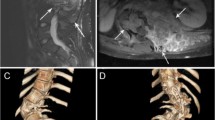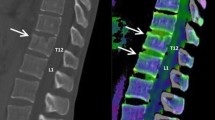Summary
Two cases illustrating the value of CT in the assessment of spinal dysraphic tissue are presented. In one case, the configuration and origins of two osseous diastematomyelic spurs were shown well; in the second case, the CT recognition of a sacral lipoma led to air myelographic confirmation of the tumor and tethered cord. CT phantom studies indicated that dysraphic tissues, such as fat, cartilage, and fibrous tissue, are better identified and quantitated in the spinal canal when surrounded by air. Varying degrees of image degradation occur with water (simulating CSF) or metrizamide.
Similar content being viewed by others
References
Hammerschlag, B. S., Wolpert, S. M., Carter, B. L.: Computed tomography of the spinal canal. Radiology121, 361–367 (1976)
Hansen, E. B., Fahrenkrug, A., Praestholm, J.: The late meningeal effects of myelographic contrast media with special reference to metrizamide. Br. J. Radiol.51, 321–327 (1978)
Harwood-Nash, D. C., Fitz, C. R., Resjo, M., Chuang, S.: Congenital and cord lesions in children and computed tomographic metrizamide myelography. Neuroradiology16, 69–70 (1978)
Haughton, V. M., Ho, K. C., Larson, S. J., Unger, G. F., Correa-Paz, F.: Comparison of arachnoiditis produced by meglumine iocarmate and metrizamide myelography in an animal model. Am. J. Roentgenol.131, 129–132 (1978)
Koehler, P. R., Anderson, R. E., Baxter, B., Sorenson, J.: The effect of computed tomography viewer controls on anatomical measurements. Presented at 26th Annual Meeting, Association of University Radiologists, San Antonio, Texas, May 1978
Lee, B. C. P., Kazam, E., Newman, A. D.: Computed tomography of the spine and spinal cord. Radiology128, 95–102 (1978)
Skalpe, I. O.: Adhesive arachnoiditis following lumbar myelography with water-soluble contrast agents: A clinical report with special reference to metrizamide. Radiology121, 647–652 (1976)
Weinstein, M. A., Rothner, A. D., Duchesneau, P., Dohn, D. F.: Computed tomography in diastematomyelia. Radiology117, 609–611 (1975)
Wolpert, S. M., Scott, R. M., Carter, B. L.: Computed tomography in spinal dysraphism. Surg. Neurol.8, 199–206 (1977)
Author information
Authors and Affiliations
Rights and permissions
About this article
Cite this article
Scatliff, J.H., Bidgood, W.D., Killebrew, K. et al. Computed tomography and spinal dysraphism: Clinical and phantom studies. Neuroradiology 17, 71–75 (1979). https://doi.org/10.1007/BF00556021
Received:
Issue Date:
DOI: https://doi.org/10.1007/BF00556021




